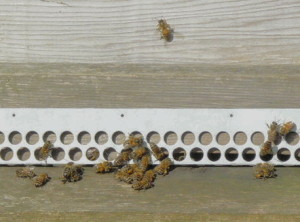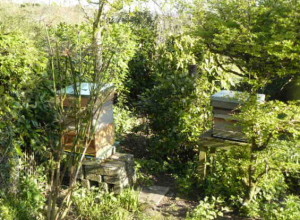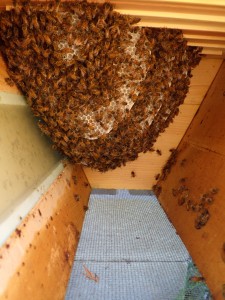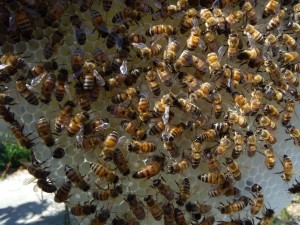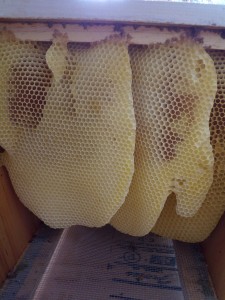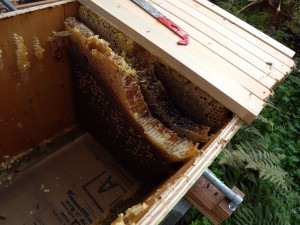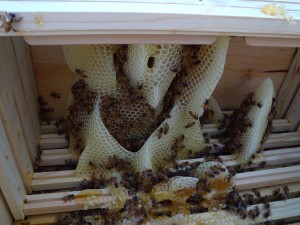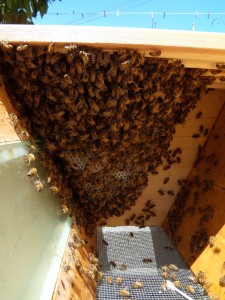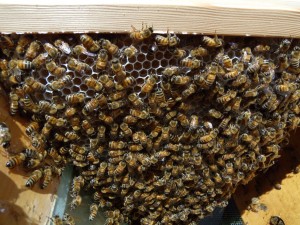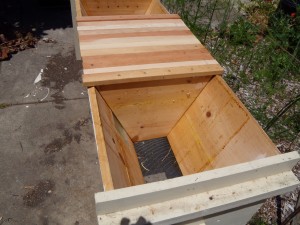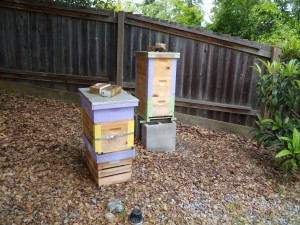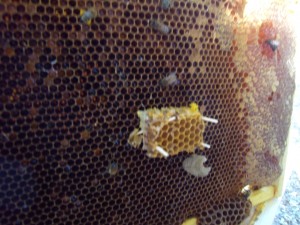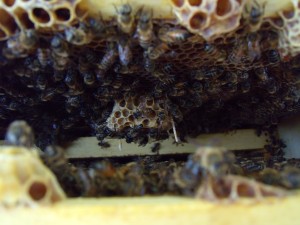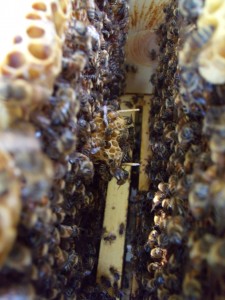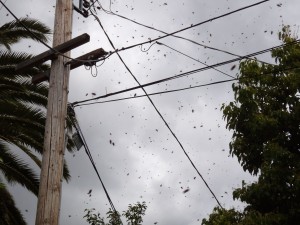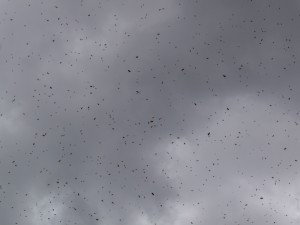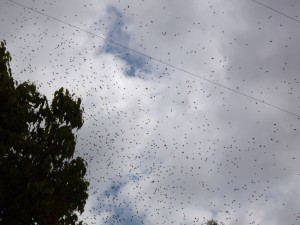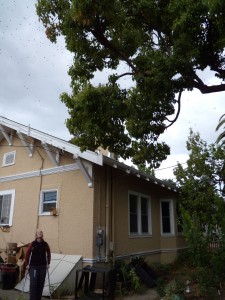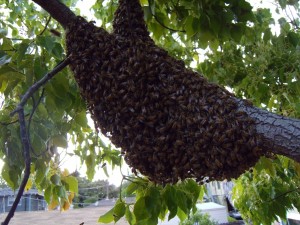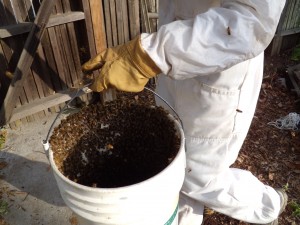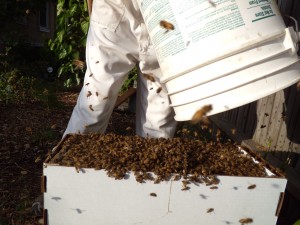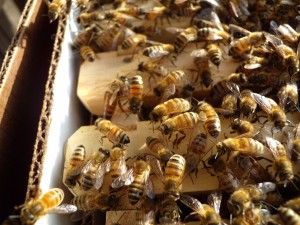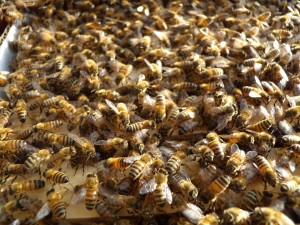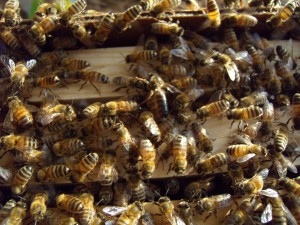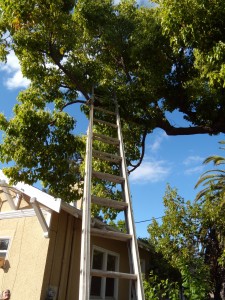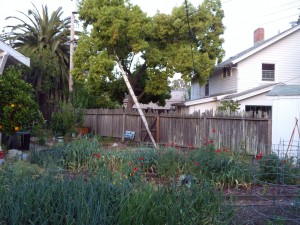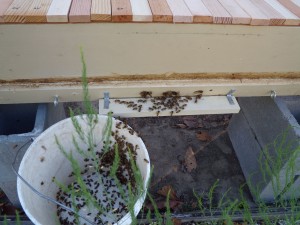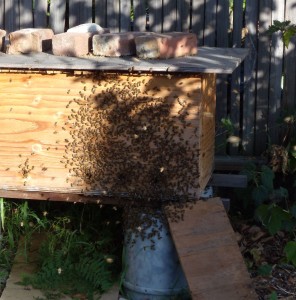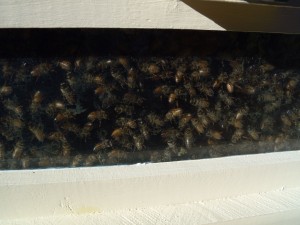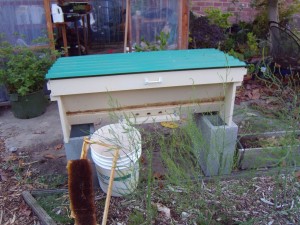The following is a guest post from longtime commenter and correspondent (our blog pen-pal, if you will), Jackie. I owe her and any faithful readers in the ether a huge apology for this 2.5 month absence. Sorry for dropping off the face of the earth. Of course, lots has happened, and of course we’ll never really manage to fill you in. But for now, without further ado, a glimpse into the world of our very favorite UK beekeeper…
Finally a warm and sunny day enabling my neighbour Debs and me to inspect our respective hives. Below average temperatures, cold blasts of Arctic wind and above average rainfall in the UK resulted in a long drawn out winter that superseded Spring and threatened to drag itself into the summer months. We had no idea what had been going on amongst the colonies as we felt it safest to leave them in peace and not risk disturbing their clusters. But the occasional sight of a brief sortie by a few brave foragers and a constant supply of home made bee candy placed on top of crown boards had given us hope that all was not lost.
So now here we are at the end of May. A pre-planned plant and seed swap event at our allotment meant we couldn’t get to our hives until late afternoon but the bees were still happily foraging in the welcome sunshine and took not one bit of notice of the first whiff of smoke as we removed the roof of Deb’s hive. We both use National hives, and hers has a clear perspex crown board enabling a good view without too much disturbance of what’s going on inside. Things looked promising when a mass of bees could be seen spilling over the top of the frames. This hive is made up of double brood boxes in an effort to allow the queen more space to lay her eggs, thus avoiding swarms–this after a previous bad year of lost bees and lack of honey. It seems to have worked because the top box currently holds 7 frames of eggs and capped brood while outer frames have plenty of fresh capped honey and nectar. Last autumn the queen had been sought, placed in the lower box and a queen excluder put between the two in order to contain her in the bottom of the hive where it should be warmer. That queen excluder had been removed in April and it seems she immediately moved upstairs to continue laying. So in spite of the awful weather bee life had continued in the confines of the hive. A sighting of eggs, larvae, capped brood and bees bringing in pollen was sufficient enough proof that the queen was present so we didn’t seek her out but instead placed a new super on the hive and popped the roof back on. So far so good!
We moved across to my garden where I currently have two hives tucked amongst hedges and shrubs that offer some protection from our inclement weather. The first one we inspected had unfortunately swarmed last year rapidly followed by two casts that left the colony so depleted they struggled to get their numbers back up before winter set in. To be honest I doubted they’d survive but think their saving grace was a late autumn supply of pollen, loved by our bees, courtesy of a relatively recent introduction into the UK of an invasive plant called Himalayan balsam. Throughout September and October its seed pods explode like party poppers, spreading the following year’s young plants further afield across our open countryside. Some consider it a menace but beekeepers can be found collecting the pods and tossing them about to their hearts content, me included! This colony is still small and although the queen is doing her best to expand their numbers I’m not sure they will tolerate her for long if she doesn’t pull her socks up. My plan is to leave that decision to the bees and wait to see if they supersede her. If not, and things don’t improve, I’ll wait until my other hive produces queen cells and then place one or two on a frame of her brood to encourage them to raise a new queen courtesy of a stronger colony. There’s already a super on this hive but I counted no more than 20 bees roaming about doing nothing constructive, and the foundation has not been drawn out so nothing to get excited about.
My second hive has a completely different story. A super added a couple of weeks ago already has frames of capped honey and plenty of bees working on it which, considering the previous bad weather, is a miracle! Double brood boxes means this queen also has room to move around, and that’s exactly what she’s done. When earlier in the year I’d replaced the old solid floor with a mesh varroa type, the top box had been almost too heavy to lift what with all the balsam honey crammed in it. But now, finally, the bees are extracting that honey for food and six frames are covered in eggs and capped brood. For all that I decided against going through the lower brood box as the bees were content so again we didn’t seek out the queen…. it’s obvious she’s doing a brilliant job and that’s all I need to know right now.
Sighs of relief all round that our bees have come through not only a dreadfully long winter but a previous year that was the wettest on record. So, comparing our experiences with those of our Overall Gardeners…. well, there really is no comparison since our principles of bee management must out of necessity differ in every way!

